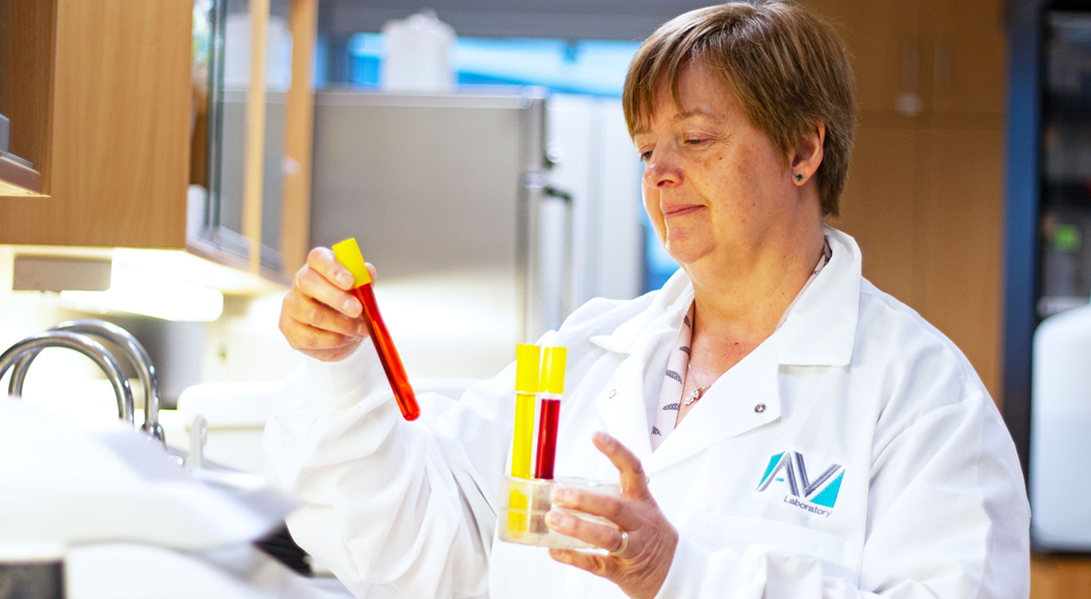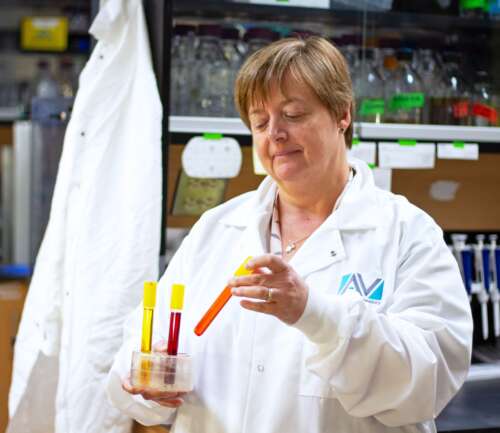


Food dyes might make food look more appealing, but their safety has long been controversial. New research from the University of Guelph reveals an unexpected way these compounds may be harming health: by disrupting the microbial communities in the gut.
The bacteria, fungi and other microbes in our gut microbiome help break down food, but they also stimulate our immune systems, and imbalances between good and bad microbes have been shown to result in several health issues, says Dr. Emma Allen-Vercoe, professor in the Department of Molecular and Cellular Biology (MCB) who researches the human gut microbiome.
“I don’t think that anyone realizes how fragile the gut microbiome is,” says Allen-Vercoe, Canada Research Chair in Human Gut Microbiome Function and Host Interactions.
“Why are so many of us missing certain microbes, and how did we lose them? One potential reason is all the artificial stuff we put into our food, including food colourants, which few people have looked at.”
Allen-Vercoe, along with College of Biological Science colleague and biochemist Dr. David Josephy, set out to address this knowledge gap by investigating azo food dyes, the class of synthetic dyes commonly used in food, drugs and cosmetics.
Allen-Vercoe’s team wanted to investigate how bacteria in the human gut metabolize or “reduce” azo dyes, and how the resulting compounds impact the growth of gut bacteria.
Four azo dyes are currently approved for human consumption in Canada: amaranth, sunset yellow, allura red and tartrazine. Many others are banned as a result of unacceptable toxicity.
While azo dyes have been tested for effects on animal cells, where they tend to be inert, their interactions with microbial cells have been mostly ignored and were not considered in the drafting of current food dye use regulations. That’s despite the fact that there is evidence azo dyes can be reduced by gut bacteria to create new metabolites that may be toxic.
“Bacteria in particular have had many eons longer than we have had to evolve. Consequently, they are incredible biochemists and azo dye reduction is not difficult for them” says Allen-Vercoe.
To evaluate the response of gut microbes to the four azo dyes, Allen-Vercoe’s team grew over 124 human gut bacterial species in culture media infused with one of the four approved dyes.
Any bacterial strains that could break down the dyes – as revealed by the disappearance of colour from the growth medium – were further tested to assess how well they functioned amid the breakdown products of azo dye reduction.
The study, published in the journal Anaerobe, revealed that many of the bacterial species typically found in the human gut could extensively reduce the dyes.
Amaranth was reduced the most frequently by gut bacteria, while tartrazine was reduced the least, although still by a substantial number of strains. In many cases, different strains of the same gut bacterial species showed variability in their reductive capabilities.

The team also found contrasting growth responses of gut bacteria upon exposure to azo dyes and their breakdown products. Some gut bacteria increased in growth while for others, growth was inhibited. For example, bacterial reduction of sunset yellow and tartrazine led to the formation of sulfanilic acid which was toxic to some bacterial species.
The findings might help explain why some people are more sensitive to azo food dyes than others. Everyone has a unique gut microbiome, and thus some people may harbour more microbes that reduce azo dyes to toxic metabolites, compared to others.
The team also conducted a second collaborative study with colleagues in New Zealand, published in the journal Food and Chemical Toxicology, focusing solely on tartrazine. That study further revealed the reduction products of the dye in the gut and their toxic impacts on host cells.
Allen-Vercoe says the studies emphasize the need for food dye regulations to be updated to include the latest findings. She notes that most of the current regulations are based on research from the 1950s and ‘60s that considered only the effects of the dyes on animal cells, and not the way the compounds are metabolized in the gut.
She adds that the risks from azo dyes concern her. “If I were able to listen to my gut microbes, they would tell me to stop consuming artificially coloured foods.”
Synthetic food colourings such as azo dyes contain no nutritious qualities, she points out, and are added to food simply to make it look more attractive.
“We need the food industry to quickly get on board with this research and, ultimately, to remove azo dyes and other artificial colours from their products.”
This research was funded by the Canada Research Chair program and the New Zealand Royal Society.
Written by Sujani Rathnayake. Sujani is a writer with SCRIBE, a program for graduate students in the College of Biological Science to gain paid experience in translating research results for a non-specialist audience.
Dr. Emma Allen-Vercoe
eav@uoguelph.ca